Ranthambore National Park is a perfect place to explore the true wilderness and to have jungle experience. A wildlife tour to this park actually gives a great experience when you add up few more worth-visiting places near this park during Ranthambore tour. There are few ultimate places near this park that may take you to the best exploration like never before. The most happening places near Ranthambore that you should include in your Ranthambore tour are Bharatpur - a true paradise for birds, Jaipur - the beautiful pink city and Agra - a heritage destination and home of Taj Mahal.
All of these three places are truly lavish in terms of delivering the highest pleasure along with enhancing overall wildlife tour experience. Those who choose any of these places along with the wildlife tour in Ranthambore, meet an experience which is enriched with cultural, birding and heritage tour. Therefore, plan a splendid wildlife tour to Ranthambore and do include all three places near this ultimate destination namely Agra, Jaipur and Bharatpur and have a lifetime tour experience that has no match around. This tour is a great way to learn the beauty of Indian culture, wildlife and heritage in single tour.
Ranthambore Fort :
This one is the most famous attraction for the tourists after the Jungle safari. One can't miss taking a look at the Ranthambore Fort which is located within the national park. The fort is the testimony to the glory of the Imperial era in Rajasthan. Until the independence of India, this fort was the part of the Jaipur State and the forest around it was used as the hunting land by the Maharaja of Jaipur. Located within the periphery of Vindhya and Aravali hills, the fort offers you an enchanting view of wildlife with the abundance of raw valleys, lakes and plenty of wild animals and birds in the thick forest spread around it. The fort has witnessed the long history of imperial Rajasthan and its changing dynamics since thousands of years.
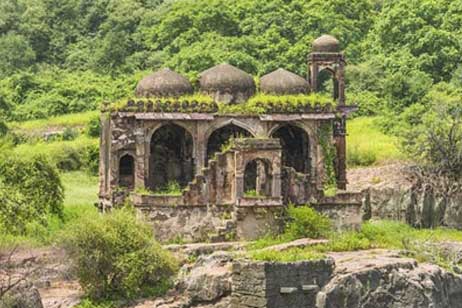

Agra - A Heritage City Near Ranthambore- :
Agra is a home of one of the Seven Wonders of the World - the Taj Mahal which attracts a number of tourists all across the world to witness the mesmerising India heritage every year. So, when you are on a tour to Ranthambore, do include Agra visit as this place has many things of tourists' interest. The city Agra is mainly famous for the Taj Mahal. Though there are several other ancient monuments that exhibit the grace of royal Mughals and Mughal architecture. So, when you are in Agra, you get a wonderful opportunity to witness these wonderful monuments of ancient time which are real heritage of India.
Agra - An Ideal City Of Mughals- :
In early time, when Mughals got reign over India, they chose Agra as their prime city. It was Agra where the main founder of Mughal Dynasty - Babur established the first ever Persian style garden across the bank of Yamuna River. After Babur, Akbar - the son of Babur and his here, raised the overlooking walls of the great monument Red Fort. Within this city, Jehangir established attractive rose-red coloured palaces, gardens and courts. After Jehangir, his son - Shahjehan overstated this place with palaces, pavilions and marbled mosques. The pavilions had gem-inlaid attractive white marble. There is a place Sikandara which is a suburb of Agra, the emperor Akbar built a garden mausoleum. In Fatehgarh Sikri, he built a complete city which was merely an imagination in the beginning, but Akbar made it possible with unique planning, great device and thus, features his expression of architecture style that had been a perfect mixture of the Hindu genius and Islamic spatial inspiration for artistic sculpture.
Across the Yamuna River, emperor Jehangir built a beautiful marble-inlaid sacred tomb for the parents of his wife as it was a gift for his queen - Noor jehan. Although, Agra has many memorable monuments of ancient Mughal Empire, yet the crowning glory of this city will always be Taj Mahal which is a monument built by emperor Shahjehan in the loving memory of his queen - Mumtaz Mahal.
Knowing More About Taj Mahal - A Symbolic Monument Of Love- :
This ancient love monument - Taj Mahal is built in the serene and lush green garden of beautiful cypresses and reflects full in the pools across the banks of Yamuna River. The white pure marble glitters silver in the night time. At down, the marble starts glowing little pink and by end of the day, the bright tints of the sun glorifies the entire surrounding. So, the TajMahal exhibits a timeless beauty which is a real inspiration for artists, painters, poets, photographers and writers. In the moonlight, you will see several young couples having a good time here.
History Of Taj Maha- :
This historical monument - the Taj Mahal was built by Shahjehan in the loving memory of his dear wife Mumtaz Mahal. Mumtaz Mahal got died while giving birth of the 14th child of Shahjehan. At the time of construction of this historical monument, no money was spared and no exception was left to make it look the prettiest monument of the globe. With a fine use of red sandstone and white marble, jasper and camelian, gold and silver, coral and lapis lazuli, jade and moonstone it was decorated with the hard labour of 20 thousand professional workers. With intense hard work, this ultimate dream of the emperor came true. In the completion of this imaginary artwork and construction of Taj Mahal, 22 years were invested. And after 22 years, a great symbol of divine love where the emperor Shahjehan was buried, finally reunited with Mumtaz - his better-half.
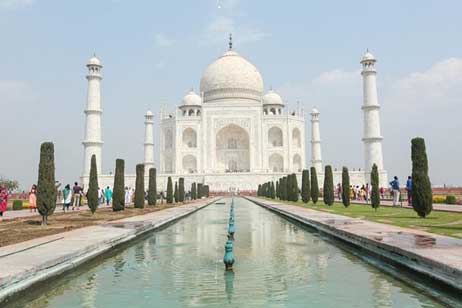
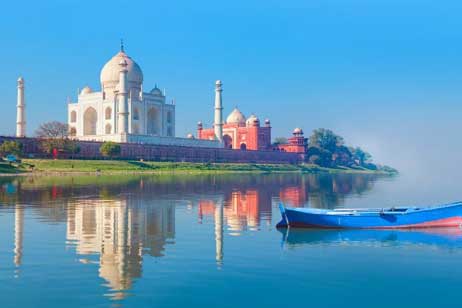
Established at the northern end of Persian garden having water courses, lanes of dense cypresses and paved walkways, this attractive monument - the Taj erects on a red high sandstone base which is roofed with a big terrace made of marble and its incredible double dome moved by 4 minarets. There is a cenotaph which is fully jewel-inlaid that relates to the queen and just to a side an asymmetrical aspect in the Taj that is greatly embellished casket for the emperor. Both of them are connected by a beautifully pierced marble octagonal screen. Thus, these are perfect proportions for the Taj and exhibits an exquisite workmanship of that time which is referred as fine-tuned by jewellers and made by giant workers.
What To See In Agra- :
Agra Fort -:
Agra fort is one of the most popular attraction i n Agra. It is among those forts in the world which are famous for a touching tale to tell to visitors. This fort was mainly designed as a military structure by Emperor Akbar; however with time, it gained more lavishness, majesty and elegance like an imperial royal palace.
So, this beautiful fort is located at just 3 kms upstream to the Ta Mahal and was constructed under the supervision and direction of Emperor Akbar. The constructor of this fort was Mohammed Quasim Khan who was the governor and commander in chief of Akbar. To complete this fort, he spent 8 year and a total expenditure was 3.5 million rupees.
The Beautiful Tomb Of Itmad-Ud-Daulah
Around 4kms away to north of the Taj, there is a well-proportioned mausoleum of the father of Noor Jehan. It is a marbled tomb located on the bank of River Yamuna and is a double-storey splendid monument. Replete with amazing mosaic and embellished with inlaid semi-precious stones, the tomb of Itmad-Ud-Daulah showcases the lavishness of that time.
Sikandra - Mesmerizing Monument In Agra -:
Located at 8 kms to the north-east side on Agra-Delhi road, Sikandra was constructed by Sikander Lodhi in 1492. Sikander Lodhi was the rule of last dynasty from Delhi Sultanate. In Mughal period, Akbar started reconstruction of this monument once again, considering it to convert it in his mausoleum; however, he could not complete it as he died earlier. Though the construction was accomplished by Jehangir - the successor and son of Akbar in 1613. Sikandra is a perfect blend of Hindu as well as Muslim architectures. It is a four story tall building made of red sandstone and features around 31 metre height. It was the first three storey building of red sandstone, but fourth in fully marble buildings.
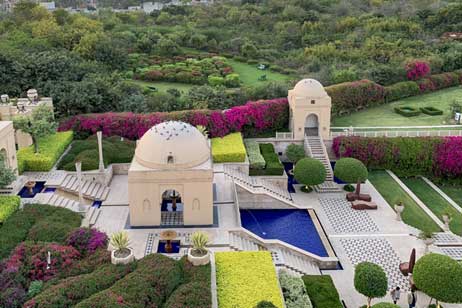

Soami Bagh Or Dayal Bagh - A Worth Visiting Monument In Agra -:
Saomi Bagh is also headquarter of the famous Radhasoami religious sect and was built in 1861 by Swami ji Maharaj - Shri Shiv Dayal Singh. As it was founded by the biggest creator, made of marble facade, decorated with beautifully designed panels and pillars, it became an expensive monument costing around five million rupees at that time. There are around 500 people accommodate around the colony near the Samadhi. People believe that Soami Bagh can give a strong competition to the splendour of the Taj Mahal once it gets completed.
Information On Traveling To Agra -:
By Road -
From traveling to Delhi, total distance of Agra is 204 kms by road.
By Air - There are daily air services available that help connecting Agra to the Capital of India - Delhi, Varanasi and Khajuraho.
By Rail - Rail network in India connects Agra to most of the cities in India.
Bharatpur :
Founded
In the 19th century, the wetland and 28.73 sq. km. lake are a manmade creation built by the Maharaja of Bharatpur. In the year 1956, it was regarded as the bird sanctuary while in the year 1981, it became the national park.
Unleashing the Bharatpur Bird Sanctuary:
Often regarded as the "Eastern Gateway of Rajasthan", Bharatpur was once a princely state. Keolodeo Ghana National Park, an important international biosphere holds importance, both local and migratory for its various and large kind of fauna. The whole is which was once a low area got converted itself into a fine wild fowl shooting preserve with the construction of small dams and diversion of water from the irrigation canal. In some years, the whole wetland got surrounded by marginal forests holding the capability to support thousands of water birds.
Nearly 300 species of birds can be found over this small park which is spread over an area of 28.73sq. km, out of which nearly 11 sq. km. of the area is full of marshes while the remaining is full of scrubland and grassland. The viewing here is made easy by undergrowth and the raised paths present here which are camouflaged by babul trees. If you wish to have an unforgettable experience then a quick ride in the early hours of the morning would be best.
Every year this place welcomes the Siberian cranes and also one can see the Indian status. Around the globe there are only two wintering pots for this rare species, one is Bharatpur and another one is in Iran. These beautiful birds with facial patches and distinctive red beaks travel a journey of 6400 km and arrive in December from Siberia to stay up until early March. This place is considered best to watch mammals like Striped Hyena, Golden Jackal, Fishing Cat, Blackbuck, Sambar, Nilgai, Jungle Cat and Wild Boar. The name of the park was derived from the temple of Keoladeo (Shiva) and the word 'ghana' that locally refers to dense, indicates towards the nature of the vegetation. At the time of cool winter months, you can also see large Indian Pythons sunning themselves.
Visiting Bharatpur :
Government Museum :
This place holds the unique glimpse of past splendor and not far from the museum, one can get to see the Bharatpur Palace that is wonderful mingle of Mughal and Rajput architecture.
- The Lohagarh Fort : this fort has stayed strong despite numerous attacks by the British.
- Deeg Palace :this great and strong fort was once the summer resort for the Bharatpur rulers as there are many gardens and palaces here. The fort is just 32 km away from Bharatpur.
- Visiting Season : you can visit the park at any time of the year.
- Breeding Season :For resident birds it is August-October while for the migratory birds, it is October-February.
- Travel Information : From Agra, by road it is 60 Km. FromFatehpirSikri, it is 24 Km while from Jaipur, it is 186 Km, 176 Km from Delhi. The railway station of Bharatpur is 6 km from the park.
Jaipur :
Jaipur was established by Maharaja Jai Singh II (1693-1743) and is also the capital city of the state, Rajasthan. The city is a major place of attraction for the first-timers. Surrounded by rugged hills, the city is crowned with forts and confined by embattled walls. The Pink city, also the old city is a great place to roam around. The entire city was painted by the pink color by the founder when Prince of Wales, later Edward VII paid a visit to Jaipur in 1876 AD. Even today, every house of the city follows this low so as to maintain the facade. Planned properly, the city was laid out in a grid pattern that was designed by the Young Bengali engineer and scholar, Vidyadhar Bhattacharya.

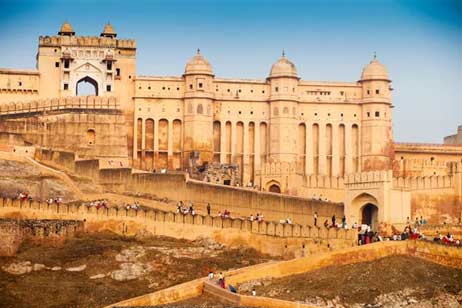
The city is the only city that symbolizes the 9 divisions of the universe, although the 9 rectangular sectors sub-divide it. The surroundings of the museum are just like an endless museum. A variety of crafts is offered by this city and the jewellers here still keep the beautiful enamel-on-gold pendants in the fashion that are studded on the opposite with precious pearls or stones & turquoise that one views in small paintings. Further, the lacquer bangles of Jaipur are famous all over the world.
Places of Jaipur that can interest anyone :
Amer Palace: This palace is placed high on the rough hills found outside the town and for 7 centuries held the court conducted by the royal house. Those who visit this place can see the majestic gateways, pavilions, courtyards and a glittering chamber of inlaid mirrors here.
Hawa Mahal: This is the most famous landmark of Jaipur and a fantasia of 1953 ornate of windows that are set in a rose-colored five story facade. The palace has a curved arch surmounted with fairy casements with "Jali", lattice work screens. From these Jalis, the ladies of the court were allowed to have a look at festive processions without risking their modest privacy.
Jal Mahal: A charming palace which is located around the Man Sagar Lake. This is the only lake palace of Jaipur which is encircled with water. It was constructed for the royal duck shooting parties.
Jantar Mantar : This is the majestic architectural astronomical instruments of Rajasthani king named Jai Singh built during the 18th century and is an amazing, three-storey-high complex.
Jantar Mantar : This is the majestic architectural astronomical instruments of Rajasthani king named Jai Singh built during the 18th century and is an amazing, three-storey-high complex.
City Palace : The Jaipur's City Palace holds a pride of peacocks that can be found at the geat of the palace and the retainers of the palace still stand in the attention as they use to stand in the past when the court of Jaipur was headquartered here. Now, this palace has turned into a fine museum. The palace holds a remarkable collection of paintings, textiles, manuscripts and amazing weapons. For the purpose of display, the palace has 2 huge urns of silver that are said to be the largest silver vessels found in the world. Nakkarkhana-ka-Darwaza, the impressive gateway of the City Palace which is safeguarded by stone elephants, is majestic.
Jai garh :The skyline in the west is dominated by the extensive walls, gateways and watch towers of Jaigarh which was constructed by Jai Singh in the year 1726. It is one of the rare army structures of medieval India that is almost preserved in its original state till now. It contains gardens, palaces, open and covered reserves, an armory, a granary, a canon foundry and many temples. For several years, it remained as the royal treasury and the world's largest cannon on wheels can also be found here.
Nahargarh Fort :Established in the year 1734, the Nahargarh Fort occupies the northwest of City Palace and contributes to some remarkable views of the city, both during the daytime and night.
Sisodia Rani Ka Bagh : This Bagh has magnificent fountains, gardens, pools & some brilliant pieces of sculpture.
Albert Hall Museum :This Museum includes the collection of natural history, yogi models that adopted various positions, dioramas depicting Rajasthani dances, tribal ware and parts of costumes, decorative arts, drawings and musical instruments.
Places of attraction in the Neighbourhood :
Bairath : One of the significant historical place that has excavated remains of a circular Buddhist temple that are unique in the Rajasthani style and are the earliest known temples. THIS historic place also has relics from the Mughal, Rajput and Mauryan periods.
Gaitor: This place has the royal family cenotaphs which can be just found outside the city walls. In particular, the cenotaph of Maharaja Jai Singh II is most impressive and that of the Maharanis of Jaipur can be found on the Ambr road which lies in between of Jaipur and Amber. Located near to this place is the Jal Mahal (water Palace) which is in the midst of the lake and can be reached by a road.
Galta :The sun god temple at Galta is 100 m above Jaipur which lies in the east direction and further has a 2.5 km climb from the Surajpol. A long, temple-studded chasm persists at the back of the temple and the surrounding plains have very good views.
Ramgarh Lake :This lake is a huge artificial lake which was constructed by a huge bund amidst tree topped hills. Although the ruins of the old fort and the temple of Jamwa Mata are some of its monuments, its gorgeous landscape, makes it an unspoiled party spot particularly during in oils pools.
Samode :This palace has been rebuilt and renovated that gives a perfect example of the Rajput haveli architecture making it an ideal spot for outings. The prime highlight of the building is the elegant Diwan-i-Khas, which is capped with real paintings and mirror work.
Sanganer :This is a small town and the entry to this town is via the ruins of two ' Tripolias ' or ' Triple-gateways '. There are a ruined palace and a group of Jain temples possessing best carvings in this town. No one is allowed to enter these temples. Importantly, one can find some of the finest hand printed textiles in this town.
Vidyadhar's Garden :Cuddled in a small channel or valley, this magnificent garden was developed in honor of Jai Singh's chief architect and town planner.
Best Season :
During the month of September and March.
Languages :
English, Hindi, Rajasthani
Travel Information :
- By Rail :An excellent and comfortable connection of railways is available from Delhi, that is, Shatabdi Express. Other solutions to Jaipur are from Jodhpur, Bikaner, Udaipur, Secunderabad, Ahmedabad, Agra, Mumbai, Lucknow and Calcutta. Some important train connections are : 9770 Express (Jaipur-Purva), Marudhar Express (Varanasi-Jaipur-Jodhpur); Shatabdi Express (New Delhi-Jaipur-Ajmer); Gujarat Mail (Mumbai-Jaipur-Delhi Sarai Rohilla); Mandore Express (Delhi Sarai Rohilla-Jaipur-Jodhpur); Superfast Express (Delhi Sarai Rohilla-Jaipur); Chetak Express (Udaipur-Jaipur-Delhi Sarai Rohilla); Intercity Express (Jaipur-Delhi Sarai Rohilla); Jodhpur Mail (Marwar-Jaipur-Delhi Sarai Rohilla) and Ahmedabad Mail (Delhi Sarai Rohilla-Jaipur-Ahmedabad).
- Road :A comfortable style of travel to Jaipur is via road which has an immense network of convenient tourist buses. The Rajasthan Roadways operates an excellent and regular service of Deluxe and AC Coaches from Delhi (From Pandara road, Bikaner House, ISBT and Kashmiri Gate). The road distances from various cities are Delhi 259 km, Jodhpur 336 km, Udaipur 405 km and Ahmedabad 657 km.
Local Transport: Unmetered auto-rickshaws, cycle rickshaws and buses are the most preferred transport that van be used to visit the inside of the city. The Rajasthan State Roadways runs a regular bus service to Amer Palace and throughout the city.